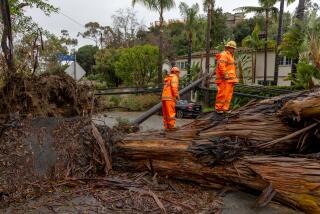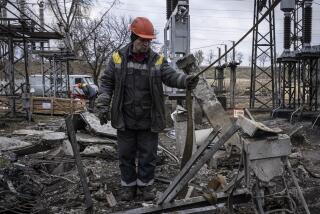Power grid increasingly vulnerable to severe weather, report says
WASHINGTON — A decade after a vast power outage shut down the Northeast, the electricity grid remains “highly vulnerable” to blackouts because of extreme weather fueled by climate change, a report by the White House and the Energy Department concludes.
The Aug. 14, 2003, blackout occurred when an alarm failed in an Ohio utility control room, leading to a cascade of blackouts that affected 50 million people from Michigan to Massachusetts. More recent power outages have been caused by severe weather, such as storms in the East and wildfires in the West.
Between 2003 and 2012, 679 blackouts occurred because of weather events, each affecting at least 50,000 customers. Over the same period, weather-related outages cost the economy between $18 billion and $33 billion annually, depending on the number and severity of events.
“The aging nature of the grid — much of which was constructed over a period of more than 100 years — has made Americans more susceptible to outages caused by severe weather,” the report said.
The analysis of the power grid, released Monday, was conducted in response to a plan that President Obama laid out in June to combat climate change and better prepare for it. Already, weather shaped by human activity has hit the United States faster than had been predicted, threatening infrastructure, water supplies, crops and shorelines, according to the draft Third National Climate Assessment, a federal report released in January.
Last year, Superstorm Sandy knocked out power for 8.5 million customers. Strong winds from hurricanes and tornadoes are the main cause of the kind of infrastructure damage that leads to blackouts, the report said.
Power plants, especially those that burn coal, contribute to climate change by emitting heat-trapping carbon dioxide. Obama directed the Environmental Protection Agency to develop rules to curtail carbon dioxide released by new and existing power plants, with the next round of proposals due in September.
The new report on the power grid spotlights the system’s vulnerabilities and offers suggestions for improvement. But it also underscores how little the administration can do to boost electricity reliability.
Most utilities are publicly traded corporations and their activities are generally regulated by the states. The Obama administration allocated $4.5 billion for investments in energy efficiency and reliability systems, called “smart grid” technology, as part of its 2009 stimulus plan. But during a conference call to discuss the report, senior administration officials were unable to name other ways to improve the electricity network at a time when threats from climate change are mounting.
Instead, the power grid report recommended replacing wooden utility poles with those made of concrete, steel and other stronger material. Burying power lines is an oft-discussed option, but the report noted it is extremely costly and, in coastal areas, underground wires are vulnerable to flooding from storm surges.
The report also recommended greater use of small-scale power sources, such as from renewable energy, that could be installed in communities or near crucial facilities, such as hospitals, to avoid outrages caused by downed power lines or flooded transmission substations.
Electric utilities have invested $478 billion in infrastructure improvements since 2007 and are expected to spend more than $90 billion annually on capital projects through 2015, said Richard McMahon, vice president of energy supply and finance at the Edison Electric Institute, a Washington trade group.
The American Society of Civil Engineers estimated that $673 billion in investments would be needed by 2020 to upgrade the grid to meet future demand. But the costs of such improvements are recouped through rate increases, often unpopular moves that must be ratified by state regulators.
More to Read
Start your day right
Sign up for Essential California for news, features and recommendations from the L.A. Times and beyond in your inbox six days a week.
You may occasionally receive promotional content from the Los Angeles Times.







